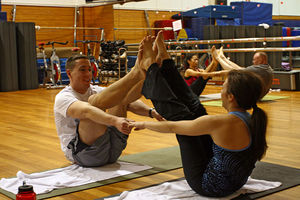
There’s a lot of talk in the world of fitness about building core strength because it’s been shown to enhance performance during other exercises, such as running and biking. Medical professionals and sports trainers also recommend building core strength to lessen chronic pain and prevent injuries.
Some mistakenly believe that core strength refers only to the stomach area, and limit their core exercises to sit-ups, crunches and other classic abdominal strength-builders. But the core actually includes the upper abdominals, side (oblique) muscles and a deep lower layer of midsection muscle called the transverse abdominus, as well as the muscles down the back, hips, glutes and thighs.
In short: if the muscles help to stabilize the spine, they’re core muscles, and if you can strengthen them, they might help you perform better athletically, improve your posture and reduce back pain.
Below are 7 tips for building abdominal and core muscles for maximum strength and agility.
Contents
Brace Yourself—
When performing any exercise to build the core, pulling your navel area inward as close to the spine as you can while still breathing comfortably is an excellent way to make sure you’re focusing on the correct muscle group.
By engaging the transverse abdominus, you’ll make sure this extremely powerful sheet of stomach muscle keeps the spine properly aligned and protected.
Stabilizing Force—
When traditional ab exercises like crunches and sit-ups are performed on an exercise ball, surrounding muscles are forced to work out along with the abs to keep the body stable. This can especially strengthen the sides of the body, creating a leaner line and stronger back.
Doing squats with an exercise ball between yourself and the wall, ball push-ups, and doing sit-ups on the ball are all examples of stability-based exercises.
A half of an exercise ball on a flat surface (called a BOSU), can be a great core builder when free weights are lifted while standing on it. If a trainer or friend can toss a medicine ball back and forth with you while you balance on a BOSU, this also works well.
Pilates, Please—
With slow, controlled movements that are all about maintaining stability, rather than reps, Pilates is an excellent core strengthener.
Remember to maintain proper form and hold Pilates poses as long as possible for maximum core benefits.
Plank You Very Much—
The plank is a popular core exercise because the body is aligned, the entire spine and surrounding muscles are engaged, and if you don’t want to collapse, the core muscles are all you have between you and the floor.
To plank, simply place elbows, lower arms and toes on the floor while holding the rest of the body up in a straight line for as long as you can, working up to a minute or longer eventually.
Side planks are the same exercise turned sideways, and really strengthen the oblique muscles. When doing any type of plank, remember to breathe and don’t overly tighten and strain the neck muscles.
Meet the Medicine Ball—
Incorporating medicine ball-lifting exercises into your workout can create core progress, especially those that make the body move from side to side, or stretch upward.
Because you’re balancing a heavy ball as you work out, you’re introducing the core-strengthening element of instability when the muscles have to work harder to hang on.
Throwing a ball at a wall and catching it on the bounce-back is also a fun way to achieve the abs of steel you’re seeking.
Get Glute-iful—
The glute muscles do more than provide us with a cushioned surface on which to sit; they also play a large role in core strength, making it just as important to work the lower body as the middle.
A popular core-building move for the gluteus and thigh muscles is the bridge exercise. This can be done by lying on the back with bent knees and raising the body up off the floor while contracting the glutes, being careful not to strain the lower back.
Go slowly and pull the navel into the spine to include the inner abs during a bridge exercise, holding each repetition for as long as you can.
Work the Weights—
While all of the weight machines don’t necessarily work the core muscles, strengthening all of the big muscles of the body can give you an edge by making it easier to build the core.
When the surrounding muscles are strong enough to support the rest of the body, it’s easier to work on the less-developed central muscles, and less likely to cause injury.
If you decide to focus on building your core, be sure to proceed slowly, as many of the exercises to build these particular muscles can injure those with weakness in the center of the body. Use the tips above with low weight until you learn the proper forms, and build up to the super strong core you’ve always wanted.
![]()

